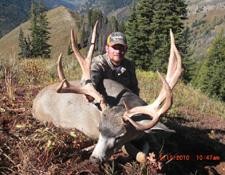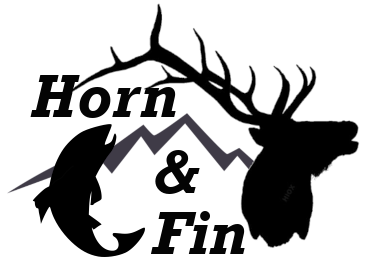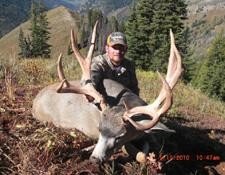- Hunting
- Discounted Guided Hunts
- Wyoming Mule Deer, Elk, Moose, Antelope, Mountain Lion, Bighorn Sheep Hunts Area 4, 7
Wyoming Mule Deer, Elk, Moose, Antelope, Mountain Lion, Bighorn Sheep Hunts Area 4, 7
Contact Info
Big Game
Small Game

Hunting in Wyoming for Mule Deer, Elk, Moose, Antelope,
Mountain Lion, Bighorn Sheep
________________________________________
This is a first class outfitting and guiding operation specializing in hunting trophy: mule deer, elk, moose, antelope, mountain lion and big horn sheep. Our hunting area and camps have been acquired from permits issued to us by the National Forest Service. Permits cover a large portion of the Bridger Teton National Forest and Gros Ventre Wilderness. These permits give us the opportunity to outfit in some of the most coveted hunting units in western Wyoming, providing us the ability to give each person a quality hunting experience.
Horseback Pack-in Wilderness Hunts: Each morning you and your guide will ride horseback well before daylight to the desired hunting area for that day. From here a good part of our hunting will be done on foot. We spend much of the day moving from various vantage points glassing the valleys and hillsides for that Trophy Buck of a lifetime. All our hunting except for Antelope is done with the use of horses and mules. We offer traditional horseback pack-in wilderness wall-tent camp hunts.
Elk Hunting: If you have always dreamed of harvesting a Bull Elk or bettering the one you already have, this is the hunt for you. Natural winter range and various nearby winter feed grounds have provided us with a high population of Elk. Our Elk hunts take place from high mountain basins to lower timber-covered hills with large meadows. Our area holds a large number of Elk giving us the ability to show hunters several Bulls during their hunt. Good elk numbers with high Bull to Cow ratios provide us with high quality Elk hunting the entire season.
Archery Elk Hunting: season opens Sept. 1st and goes through Sept. 25th. Because we hunt from remote pack-in camps we are able to reach far into the backcountry and bugle bulls that don’t receive much hunting pressure providing us with many shot opportunities and a high success ratio. This is a super hunt for the serious archer intent on taking a bull with their bow.
Mule Deer Hunting: This area is famous for some of the best Trophy Mule Deer hunting in the world. This region of western Wyoming has all the ingredients for growing Trophy Class Bucks: genetics, ample vegetation, high mountain basins, natural winter range and the necessary cover and hidey-holes that allow Bucks to reach their maturity. Much of the area in which these Trophy Bucks live is also very remote and rugged. We encourage each hunter to prepare physically, increasing the opportunity of harvesting a Trophy Class Deer.
Big Horn Sheep Hunting: We put out an unmatched effort to provide each hunter great opportunities on Rocky Mountain Big Horn Sheep. We specifically focus our sheep hunts in areas 4 and 7. We know each of these areas from one end to the other and also the best places to find good rams. Our sheep hunts take place from a remote backcountry spike camp.
Antelope Hunting: Antelope hunts take place on private ranches and also BLM public ground in the high sagebrush plains of western Wyoming.
Accommodations consist of a ranch house, lodge or motel cabins depending on the unit you are hunting.
Moose Hunting: If you have Moose points give us a call. Western Wyoming is known for producing Trophy Bull Moose. The areas we hunt are no exception. Each year we locate several Bulls that range from 40-50 in. wide. Moose tags can be difficult to draw but are well worth the effort.
Mountain Lion Hunting: snow fall provides us the best tracking conditions. We use snowmobiles and 4x4 vehicles to look for Lion tracks. After a track is found we turn the dogs out to follow the track and put the Cat in a tree.
General Hunting Information:
Application Deadlines
Mule DeerMar. 15
ElkJan. 31
AntelopeMar. 15
MooseFeb. 28
SheepFeb. 28
Hunting Dates
Mule DeerSep. 15 - Oct. 10
Rifle ElkSep. 26 - Oct. 31
Archery ElkSep. 1 - Sept. 25
Deer/Elk ComboSep. 26 - Oct. 10
Deer/AntelopeSep. 13 - Oct. 10
AntelopeSep. 10 - Oct. 31
Moose area 10,21Sept. 10 - Oct. 31
Sheep area 4Sep. 1 - Oct. 20
Sheep area 7Sep. 1 - Oct. 31
Preference Points
*Preference points can be purchased from July 1 - September 30.
*Hunting licenses can be applied for and preference points bought by going to the Wyoming Game and Fish website. http://gf.state.wy.us
*We will do the preference point purchase and hunting license application for you. Elk licenses need to be done before January 31.
Gear List Frequently Asked Questions Useful Links
Gear:
Gear List
•Good Rifle - 270, 30-06, 300, 338, etc.
•2 Boxes of Bullets, may have to sight gun in if bumped on trail
•Light weight Shooting Sticks, Stoney Point Steady Stix II 39in work great, bipods don't fit into the scabbard, shooting poles are hard to carry with you on the horse
•Game Bags for Meat, Cheese cloth game bags work great
•Pair of well broke in Hiking Boots & Snow Boots for late October hunts
•Day Pack or Back Pack
•2 Water Bottles
•Rain Gear - Gortex or Dry Plus work great
•Camera
•Good Binoculars - spotting scope optional (guide carries spotting scope)
•Hunting Knife
•Flash Light or Head Lamp
•Warm Sleeping Bag - rated to zero or winter weight
•Warm Coat - dress in layers as it may be cold in the morning and hot in the day, wool or gortex is great
•Gloves one light and one or two pair heavy for cold or snow
•Cap and Stocking Hat or Winter Hat to keep ears warm
•One Article of Orange, hat or vest will work (bow hunters exempt)
•3 pairs of Pants, one wool or cold weather material
•3 set of Long johns, 5 sets of Underwear, 5 pairs of Socks
•3 Shirts
•Personal Kit, Chapstick, Hand Lotion, 1 Washcloth, 1 Towel, Medication, Aspirin for aches and pains
•Sun Glasses, Loafing Shoes for around camp
•Hunting License
The weather in the months of September and October can be 60 degrees or 10 degrees and snowing. Be prepared for either. Temperatures are usually warm during early September. Archery hunts can be 60 degrees, or 30 degrees and snowing.
Because horses are required to pack all gear into camp we have a weight limit of 60 lbs., two duffel bags per person plus your backpack and rifle which you will carry with you on your horse. You will only be allowed 2 bags and 60 pounds to be loaded on the pack stock! Gear will be weighed.
Bow hunters need 3 stamps. Rifle elk hunters need 2 stamps. Deer hunters need 1 stamp. A $12.50 conservation stamp is required for all hunters. Bow hunters must buy a $25.00 archery license. All Elk hunters must buy a $12.50 special elk feed ground stamp. These stamps may be purchased online or at any store or gas station where Wyoming hunting licenses are sold. (prices subject to change)
Frequently Asked Questions
How far are your average shots?
-Average shots are between 150 – 300 yards, but if you have the ability practice shooting 350 – 400 yards. There are circumstances when we can’t get any closer. Know your gun and where it shoots.
What caliber of rifle should I bring?
-I recommend bringing the rifle that you have the most confidence in. Obviously the higher power the better, but bring a gun you shoot well. I prefer a 30-caliber rifle and I like a 300mag.
How far of a ride is it into camp?
-It is a 3-hour ride into two of our camps and 1 ½ hr ride to the other.
Which is the best Camp?
-All 3 camps are very similar and can provide an outstanding hunt. From the terrain to the amount of game all three camps are very much the same as they are located in the same mountain range.
Is my sleeping bag and gun included in the 2 bags and 60 lb weight limit?
-The 60 lbs does include your sleeping bag, but not your gun or backpack.
Do you own or rent your horses? And what if I don’t have any horse riding experience?
-We do own all of our horses and mules. The horses we have are big, gentle mountain horses and are accustomed to inexperienced riders.
What stamps do I need and where can I get them?
All hunters need to purchase a conservation stamp. Elk hunters need to buy a special elk feed ground stamp and archery hunters need to buy an archery license. Stamps can be purchased on the Wyoming Game and Fish website or at a gas station or sporting store in Wyoming where licenses are sold.
What airport do I fly into?
-I recommend flying into the Jackson Hole airport. From here you can take a cab into town to your motel where we will pick you up the following day. You can also fly into Salt Lake City or Idaho Falls airports but you will have to rent a car and drive to Jackson.
What will be done with my trophy after it is down?
-Once you have got your animal down your guide will field dress, cape, and quarter your trophy. Then a wrangler packs the meat and quarters down to the meat processor in Jackson. There is no extra charge for quartering, caping, and packing out your game. Processing is at your own expense. Trophy Mountain Outfitters is NOT responsible for processing or shipment of meat, capes, and horns.
How can I get my meat and horns home?
-I recommend driving out if at all possible. If you are not able to drive and you fly out meat and horns can be shipped home, but shipping meat is very expensive. Some hunters arrange their meat and horns to be taken home for them by other hunters or Barry. Horns must have an interstate game tag for this, which you can get at the processor or Game and Fish office in Jackson.
Can I donate my meat if I don’t want to take it home?
-Meat can be donated to the food bank for needy families. The hunter has to pay for processing then let the processor know you want the meat donated.
Do I need to wear orange?
-The law states that a rifle/gun hunter has to wear 1 article of florescent orange; hat, vest, or coat.
Do I need a hunter safety card?
-Any person born on or after January 1, 1966 must have passed hunters education.
Can my deposit be refunded?
-A deposit is only refunded if a hunter is unsuccessful in the license draw. If unsuccessful in the draw your deposit can be refunded or rolled over to the next year. If a hunter backs out on their hunt before the draw or after a license has been drawn then there is no refund on the deposit.
What is the best week to come?
-The best week varies from year to year. Weather is a huge factor in which week is the best each year. The area we hunt has a lot of game and we do well throughout the season. There is not a bad time to come.
Will we come back to camp for lunch?
-Unless we get an animal down we usually don’t come back to camp after we leave in the morning. We take a sack lunch with us and have lunch on the mountain then return to camp at or just after dark for supper.
Do you guide and do you have the same guides each year?
-Yes, We have the same guides each year. Our guides are close friends and family. Without a doubt has the best group of guides, cooks, and packers. This is what makes us so successful each year. We are a family run operation in which we all take a lot of pride. I believe the secret to success is surrounding yourself with great people.
How good of shape do I need to be in and what is the terrain like?
-The better shape you are in the better your odds of doing what is physically needed to take the trophy you are looking for. We hunt from 7,000 – 10,000 feet in elevation. Horses are used as much as possible, but hiking is also required depending on where the game is located. The terrain might be gentle rolling hills or straight up and down. It is a high mountain hunt and physically demanding. Do your best to be in good shape.
What does an average day consist of?
-On the average we get up between 3:00 – 4:30 a.m. Guides saddle horses while hunters eat a hearty breakfast in the cook tent. Lunches are packed and we hit the saddle 1 – 2hrs before sunup. The day is spent glassing the terrain and moving from various vantage points either by riding or hiking. Most of the hunting is spot and stalk, but we will do whatever is needed to provide shot opportunities. Lunch is enjoyed on the mountain as we spend the whole day hunting. We return to camp for a full coarse supper usually served around 7:00 – 8:00 p.m.
Can I bring a non-hunter with me?
-If you are hunting from the lodge there is no problem bringing a non-hunter. If hunting from a pack in tent camp it depends on camp availability. The cost is $250 per day for non-hunters.
Can I continue to go out and hunt with my partner after I have filled my tag?
-If hunting from the lodge yes, because we have availability to a lot of riding stock. If hunting from a pack-in tent camp this call comes down to the guide. There are times when the horses are tired, sore, and need a rest so your guide may ask you to stay in camp a day or two. Our stock put in a long season beginning mid-July and go almost daily until the first part of November. Be assured we will have you go along as much as possible.
How much should I tip my guide and what about the cook and packers?
-Tips vary greatly as everyone’s financial situation is different. Tips for guides range from $200 - $1000 or more. 10% of the price for your hunt is a good way to gauge what you should tip. The cook and packers usually are tipped less than the guide and an average tip is $50 - $100 but can be higher. Tip what you can and what you feel the guide, cook, and packer deserve. They will work hard for you.
How Do I book a hunt?
-A 50% deposit is due at the time of booking your hunt. A booking form also needs to be filled out.
``Necessities for a successful hunt''
1. Lots of Good Food
2. Comfortable Clean Camp
3. Area with Lots of Game
4. Experienced & Enthusiastic Guide
5. Friendly Atmosphere, Western Hospitality
We know what it takes and pride ourselves in doing everything possible to provide each and every person with a positive hunting experience. We ask that each hunter come with a positive attitude and be as well prepared as they possibly can. Much of the terrain where these trophy animals live is steep and rugged. The better physical shape you are in the better chance you have of getting the animal you are looking for. Hiking, horseback riding, and being familiar with your rifle are a few of the things that you can do to help increase the successfulness of your hunt.
Useful Links:
Wyoming Game and Fish Website
Hunt ID: ElkMDeerAntelopeSheepMooseLion-TMO-Daniel-Open
{BreezingForms:Hunt_Special_Information_Request_Form}

